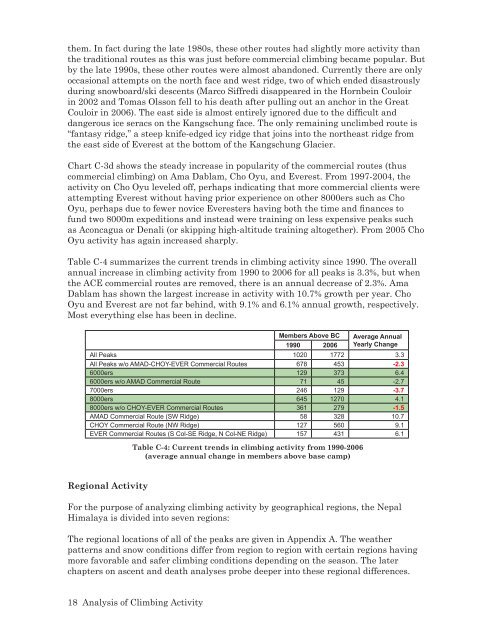The Himalaya by the Numbers: A Statistical Analysis - Himalayan ...
The Himalaya by the Numbers: A Statistical Analysis - Himalayan ...
The Himalaya by the Numbers: A Statistical Analysis - Himalayan ...
You also want an ePaper? Increase the reach of your titles
YUMPU automatically turns print PDFs into web optimized ePapers that Google loves.
<strong>the</strong>m. In fact during <strong>the</strong> late 1980s, <strong>the</strong>se o<strong>the</strong>r routes had slightly more activity than<br />
<strong>the</strong> traditional routes as this was just before commercial climbing became popular. But<br />
<strong>by</strong> <strong>the</strong> late 1990s, <strong>the</strong>se o<strong>the</strong>r routes were almost abandoned. Currently <strong>the</strong>re are only<br />
occasional attempts on <strong>the</strong> north face and west ridge, two of which ended disastrously<br />
during snow board/ski descents (Marco Siffredi disappeared in <strong>the</strong> Hornbein Couloir<br />
in 2002 and Tomas Olsson fell to his death after pulling out an anchor in <strong>the</strong> Great<br />
Couloir in 2006). <strong>The</strong> east side is almost entirely ignored due to <strong>the</strong> difficult and<br />
dangerous ice seracs on <strong>the</strong> Kangschung face. <strong>The</strong> only remaining unclimbed route is<br />
“fantasy ridge,” a steep knife-edged icy ridge that joins into <strong>the</strong> north east ridge from<br />
<strong>the</strong> east side of Everest at <strong>the</strong> bottom of <strong>the</strong> Kangschung Glacier.<br />
Chart C-3d shows <strong>the</strong> steady increase in popularity of <strong>the</strong> commercial routes (thus<br />
commercial climbing) on Ama Dablam, Cho Oyu, and Everest. From 1997-2004, <strong>the</strong><br />
activity on Cho Oyu leveled off, perhaps indicating that more commer cial clients were<br />
attempting Everest without having prior experience on o<strong>the</strong>r 8000ers such as Cho<br />
Oyu, perhaps due to fewer novice Everesters having both <strong>the</strong> time and finances to<br />
fund two 8000m expeditions and instead were training on less expensive peaks such<br />
as Aconcagua or Denali (or skipping high-altitude training altoge<strong>the</strong>r). From 2005 Cho<br />
Oyu activity has again increased sharply.<br />
Table C-4 summarizes <strong>the</strong> current trends in climbing activity since 1990. <strong>The</strong> overall<br />
annual increase in climbing activity from 1990 to 2006 for all peaks is 3.3%, but when<br />
<strong>the</strong> ACE commercial routes are removed, <strong>the</strong>re is an annual decrease of 2.3%. Ama<br />
Dablam has shown <strong>the</strong> largest increase in activity with 10.7% growth per year. Cho<br />
Oyu and Everest are not far behind, with 9.1% and 6.1% annual growth, respectively.<br />
Most everything else has been in decline.<br />
Regional Activity<br />
For <strong>the</strong> purpose of analyzing climbing activity <strong>by</strong> geographical regions, <strong>the</strong> Nepal<br />
<strong>Himalaya</strong> is divided into seven regions:<br />
<strong>The</strong> regional locations of all of <strong>the</strong> peaks are given in Appendix A. <strong>The</strong> wea<strong>the</strong>r<br />
patterns and snow conditions differ from region to region with certain regions having<br />
more favorable and safer climbing conditions depending on <strong>the</strong> season. <strong>The</strong> later<br />
chapters on ascent and death analyses probe deeper into <strong>the</strong>se regional differences.<br />
18 <strong>Analysis</strong> of Climbing Activity<br />
Members Above BC Average Annual<br />
Yearly Change<br />
1990 2006<br />
All Peaks 1020 1772 3.3<br />
All Peaks w/o AMAD-CHOY-EVER Commercial Routes 678 453 -2.3<br />
6000ers 129 373 6.4<br />
6000ers w/o AMAD Commercial Route 71 45 -2.7<br />
7000ers 246 129 -3.7<br />
8000ers 645 1270 4.1<br />
8000ers w/o CHOY-EVER Commercial Routes 361 279 -1.5<br />
AMAD Commercial Route (SW Ridge) 58 328 10.7<br />
CHOY Commercial Route (NW Ridge) 127 560 9.1<br />
EVER Commercial Routes (S Col-SE Ridge, N Col-NE Ridge) 157 431 6.1<br />
Table C-4: Current trends in climbing activity from 1990-2006<br />
(average annual change in members above base camp)


